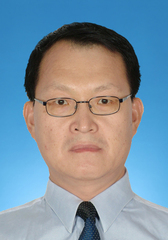
Tel: +86 (0755) 2603-6348
Email: wu.yaojiong@sz.tsinghua.edu.cn
Address: Building L Room 406A
2000-2003, Ph.D., University of Toronto
1983-1986, M.S., Lanzhou University
1978-1983, M.D., Qingdao Medical College
2008-present, Professor, Life Science Division, Graduate School at Shenzhen, Tsinghua University, China
2005-2008, Assistant Professor, Department of Surgery; Department of Biochemistry, Faculty of Medicine and Dentistry, University of Alberta, Canada
2003-2005, Research Associate, Department of Medicine, Brigham & Women’s Hospital and Harvard Medical School, Boston; and Duke University Medical Center, Durham (Lab relocation), USA.
1998-1999, Postdoctoral Fellow, University of British Columbia, Vancouver, Canada
1994-1997, Associate Professor, Department of Medicine, Xuanwu Hospital, Capital Medical University, Beijing, China
1986-1997, Physician, Cardiologist, Department of Medicine, Xuanwu Hospital, Capital Medical University, Beijing, China
· Niches for stem cell self-renewal, regeneration and organogenesis;
· Epigenetic regulations of stem cell self-renewal;
· Mesenchymal stem cell trafficking, homing and tissue repair/regeneration;
· Bioengineering of the skin and hair follicle neogenesis
Niches for stem cell self-renewal, regeneration and organogenesis;
Epigenetic regulations of stem cell self-renewal;
Mechanisms of mesenchymal stem cell trafficking, homing and tissue repair/regeneration;
Bioengineering of the skin and hair follicle neogenesis
Advances in stem cell research and therapies
Advances in molecular and cell biology
Cell biology, Precision medicine, Biopharmaceutical sciences
Niches for stem cell self-renewal, regeneration and organogenesis;
Mechanisms of mesenchymal stem cell trafficking, homing and tissue repair/regeneration;
Bioengineering of the skin and hair follicle
Development of cellular therapeutic products
National Natural Science Foundation of China;
National Key R&D Program of China
State Key Laboratory of Chemical Oncogenomics
Shenzhen Science and Technology Innovation Committee
……
[1]Li Y, Dong Y, Ran Y, Zhang Y, Wu B, Xie J, Cao Y, Mo M, Li S, Deng H, Hao W, Yu S, Wu Y*. Three-dimensional cultured mesenchymal stem cells enhance repair of ischemic stroke through inhibition of microglia. Stem Cell Res Ther. 2021; 12(1):358.
[2]Wang J, Wang XX, Xie J, Yao B, Mo M, Ma D, Huang C, Xu RH, Fu X, Tredget EE*, Wu Y*. Engineered skin substitute regenerates the skin with hair follicle formation. Biomedicine 2021; 9(4):400.
[3]Chen H, Wang X, Chen Y, Han J, Kong D, Zhu M, Fu X, Wu Y*. Pten loss in Lgr5+ hair follicle stem cells promotes SCC development. Theranostics 2019; 9(26):8321-8331.
[4]Mo M, Zhou Y, Li S, Wu Y*. 3D culture reduces cell size by increasing vesicle excretion. Stem Cells 2018; 36(2):286-292.
[5]Wang X, Chen H, Tian R et al. Macrophages induce AKT/β-catenin-dependent Lgr5+ stem cell activation and hair follicle regeneration through TNF. Nature Communication. 2017; 27;8:14091
[6]Wang X, Wang X, Cai T et al. De novo hair follicle and sebaceous gland regeneration with cultured stem cells. Stem Cells Translational Medicine. 2016; 5(12):1695-1706.
[7]Wang X, Wang J, Guo L et al. Self-assembling peptide hydrogel scaffolds support stem cell-based hair follicle regeneration. Nanomedicine. 2016; 12(7):2115-2125
[8]Wang S, Guo L, Ge J et al. Excess Integrins Cause Lung Entrapment of Mesenchymal Stem Cells. Stem Cells. 2015;33:3315-3326.
[9]Wang X, Ge J, Tredget EE et al. The mouse excisional wound splinting model, including applications for stem cell transplantation. Nat Protoc. 2013;8:302-309.
[10]Wu Y, Zhao RC, Tredget EE. Concise review: bone marrow-derived stem/progenitor cells in cutaneous repair and regeneration. Stem Cells. 2010;28:905-915.
[11]Chen L, Tredget EE, Wu PY et al. Paracrine factors of mesenchymal stem cells recruit macrophages and endothelial lineage cells and enhance wound healing. PloS One. 2008;3:e1886.
[12]Wu Y*, Chen L, Scott PG et al. Mesenchymal stem cells enhance wound healing through differentiation and angiogenesis. Stem Cells. 2007;25:2648-2659.
[13]Wu Y, Ip JE, Huang J et al. Essential role of ICAM-1/CD18 in mediating EPC recruitment, angiogenesis, and repair to the infarcted myocardium. Circulation Research. 2006;99:315-322.
[14]Wu Y, La Pierre DP, Wu J, Yee AJ, and Yang BB. (2005) The interaction of versican with its binding partners. Cell Res. 15: 483-94.
[1]Wu et al. Self-assembly peptides in tissue engineering and regeneration. Biomaterials and Tissue Regeneration (edited by Fu Xiaobing). People's Health Press, 2019
[2]Wu Y and Zhao RC. Mesenchymal Stem Cell Homing to Injured Tissues. Essentials of Mesenchymal Stem Cell Biology and Its Clinical Translation (edited by Zhao, RC). Springer Dordrecht Heidelberg New York London, 2013.
[3]Wu Y and Tredget EE. Pathology of Tissue Regeneration and Repair: Skin Regeneration. Pathobiology of Human Disease: A Dynamic Encyclopedia of Disease Mechanisms (edited by Frank PG), Elsevier, 2013.
A method to restore the potency of mesenchymal stem cells. ZL201210326437.5
Uses of TSA in maintenance of stem cell potency in culture. ZL201310257145.5
Composition of peptides and uses in stem cell transplantation. ZL201410220064.2
A method to regenerate the skin including sebaceous glands. ZL201410723513.5
Chinese Society for Biomaterials Science and Technology Award 2021, 1st prize
Guangdong Natural Science Award 2019, 2nd prize;
Shenzhen Natural Science Award 2016, 2nd prize;
Shenzhen Overseas High-Caliber Personal 2012
CIHR Fellowship Award (Canada) 2004